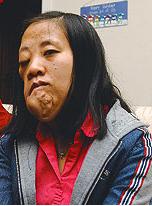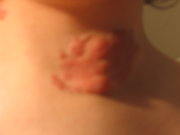Von Recklinghausen disease
Neurofibromatosis is a autosomal dominant genetic disorder. more...
Types
There are two major forms:
- Neurofibromatosis type I (was known as Von Recklinghausen disease after Friedrich Daniel von Recklinghausen). Incidence is 1:3000.
- Neurofibromatosis type II (or "MISME Syndrome"). Incidence is 1:40,000.
- Six other, extremely rare, forms are also recognized:
- OMIM 162210
- OMIM 162220
- OMIM 162240
- OMIM 162260
- OMIM 162270
- OMIM 601321
Symptoms
Neurofibromatosis type 1 - mutation on chromosome 17
- multiple neurofibromas on the skin and under the skin
- various other skin phenomena such as freckling of the groin and the arm pit
- a predisposition to particular tumors (both benign and malignant)
- the presence of 6 or more Café au lait spots (pigmented birthmarks) may suggest the presence of this condition
- skeletal abnormalities such as scoliosis or bowing of the legs might occur
- lisch nodules (iris nevi)
- tumor on the optic nerve
Neurofibromatosis type 2 - mutation on chromosome 22
- bilateral tumors, acoustic neuromas on the vestibular-cochlear Nerve
- the hallmark of NF 2 is hearing loss due to acoustic neuromas around the age of twenty
- the tumors may cause:
- headache
- balance problems
- facial weakness/paralysis
- patients with NF2 may also develop other brain tumors
Genetics and Hereditability
Both NF1 and NF2 are autosomal dominant disorders, meaning that only one copy of the mutated gene need be inherited to pass the disorder. A child of a parent with NF1 or NF2 and an unaffected parent will have a 50% chance of inheriting the disorder.
Complicating the question of heritability is the distiction between genotype and phenotype, that is, between the genetics and the actual manifestation of the disorder. In the case of NF1, no clear links between genotype and phenotype have been found, and the severity and specific nature of the symptoms may vary widely among family members with the disorder (Korf and Rubenstein 2005). In the case of NF2, however, manifestations are similar among family members; a strong genotype-phenotype correlation is believed to exist (ibid).
Both NF1 and NF2 can also appear spontaneously through random mutation, with no family history. These spontaneous or sporadic cases account for about one half of neurofibromatosis cases (ibid).
Family
Neurofibromatosis is considered a member of the neurocutaneous syndromes (phakomatoses). In addition to the types of neurofibromatosis, the phakomatoses also include tuberous sclerosis, Sturge-Weber syndrome and von Hippel-Lindau disease. This grouping is an artifact of an earlier time in medicine, before the distinct genetic basis of each of these diseases was understood.
Read more at Wikipedia.org




